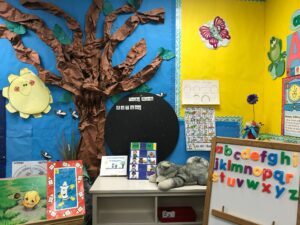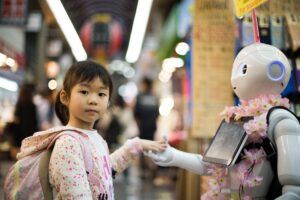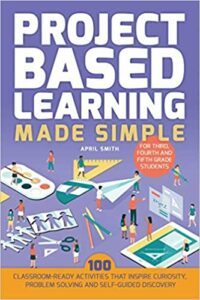Globally there is need for employees with expertise in the science, technology, engineering and mathematics ( STEM) field. The future of nations depend on their capability to prepare citizens to solve current and future problems. Exposure to the STEM field must start at an early age to ensure our children are building their STEM awareness and gain confidence to do well in STEM related subjects in school. It is important that teachers, parents and families have a clear understanding of how to assist children to hone 21st century skills and build their STEM awareness. Project-Based Learning (PBL) is one solid method that has been proven to assist children to build their STEM fluency and hone 21st century skills to ensure they secure the many jobs in STEM related field.

Monica Sedra
What is Project-Based Learning?
Project-Based or Problem-Based or Challenge-Based Learning, is a student-centered approach that engages students in a real-world situation or problem to solve. Project-Based Learning creates a need to learn and children carry out inquiry based on this need and or interest. They are fully engaged in the learning process. The focus is not the adult as an instructor dictating content but rather children learning through problem solving by taking ownership of their learning and build understanding. Children have the opportunity to engage in real world situations by using background knowledge and new knowledge to investigate and find solutions to problems.

Elisabeth Wales
The Project-Based Learning experience can begin as early as kindergarten and continue right up to professional career. Such approach to learning allows children to shift their roles from traditional teaching methods. Hence, children are not passive recipients of information but active in making choices on how to generate, obtain, manipulate and display, knowledge, principles and skills in practical ways.
Benefits of Project-Based Learning
Research attest, Project-Based Learning results in higher academic achievement when compared to more traditional teaching and learning methods. This is so because:
- It supports increased retention of information
- It challenges students to think critically and hone 21st century skills such as critical thinking, problem solving, persistence, collaboration and communication.
- It improves students’ ability to gather, synthesize, and analyze data
- It fosters students’ curiosity, creativity, and ingenuity in addressing real-world problems
- It fosters skills that are important prerequisites for STEM careers, by preparing students to improve their knowledge of math, science, engineering and to develop technological skills
- Knowledge can be constructed socially through interaction and discussion with teachers, other learners, family, friends and professionals
- Knowledge becomes personal and embedded within a context that is relevant to the learner’s own experience.
David Clode
How Project-Learning Works?
Project-Based Learning follows a constructivist approach to learning. The constructivism learning theory implies students learn better by actively participating in the learning process. To involve children in this process, projects are central to the curriculum. What is the project to undertake? Defining the project and determining the starting point of the investigation is the first step. Themes can be taken from the curriculum, family interest, child’s interest, interest in STEM related matters, interest in school, local community, region, a national or global news focus, television show, documentary, story read, observation, and share curiosity may give authentic purpose to engage in a project .

Mar Munoz
Determine standards you want to address in a project. Define clear objectives along with investigation. Use open-ended questions that arise from children’s interests and opportunities to make predictions, generate hypotheses, and gather information, materials and resources. Information resources are very essential in assisting children to construct mental models, formulate hypotheses and solve problems. Teachers, parents and families may scaffold by giving procedural guidelines, added resources, materials, pose new questions for children’s consideration and extended thinking about the problem and solution.
Project Ideas
There are so many ideas that teachers, parents, families and children can generate for projects. Seasonal themes are great to start with. Christmas is close so why not engage in a Christmas project that is based on children’s interest. The focus of projects are part of STEM learning. Any interest in the STEM field can be made into a project from investigating how caterpillars turn into butterflies for kindergarten children by extending a story such as the Very Hungry Caterpillar to making robots through coding for middle scholars. There are a number of project- based learning books that teachers, parents and families can use in creating projects. This post presents some of these resources as top recommendations.

Andy Kelly
Parental Involvement
Parents and families should always provide support for children and work along with school to provide the best opportunities for children to achieve academic success. Parents may undertake projects with their children at home to extend children’s learning, curiosity and interest. Additionally, parents and families may support Project -Based Learning opportunities at school by :
- Actively helping to plan parts of lesson units with teachers
- Set meetings with teachers and professional partners to contribute to a project
- Securing the materials and other resources for a unit being planned
- Meeting with students during a project who need extra challenge or support
- Arrange meetings for students to speak and work directly with professionals in the STEM industry
- Build partnerships with individuals, businesses and organizations to enable students to gain authentic experience and learning opportunities

Margaux Olverd
Identify service learning opportunities especially by forging partnerships with non-profit and government organizations. NASA supports project learning and provides opportunity for children at different grade levels. RePlay for Kids, an organization that repairs and adapts toys and assistive devices for children with disabilities, could work with students who collect toys for repairs to make such devices functional to distribute to children with disabilities.
Establish after school clubs in STEM disciplines example coding clubs, robotic clubs, science clubs, community gardening club and career clubs. There are number of community volunteers and professionals who are willing to give support in specialized areas. Parents can leverage support within your own community.
Disclosure-This page has affiliate or referral links. As an Amazon Associate, I earn from qualifying purchases. This means I receive a small commission if you decide to click through and buy anything. This is at no extra cost to you but helps me to maintain my website. The information in this post is based on research and professional experience. I am not paid for my opinions, suggestions or recommendations. I take the time to research the resources and make them available to you. I never recommend poor-quality products or create false reviews for sales. You are free to make your own decisions when purchasing. Full Disclosure
Recommended Project -Based-Learning Resources
Whether supporting your child at home or giving support for children at school here are some resources you can purchase to provide insights into generating ideas and carrying out projects. Click on the title to purchase on Amazon.
1. Hands-On STEAM Explorations for Young Learners: Problem-Based Investigations for Preschool to Second Grade

Hands-On STEAM Explorations for Young Learners: Problem-Based Investigations for Preschool to Second Grade will use popular children’s nursery rhymes to explore STEAM concepts through hands-on, minds-on investigations. Children ages 4 through 8 their teachers and parents will love this twist on familiar old nursery rhymes.
Children will enjoy problem solving and tinkering as they discover and explore. Black sheep insists that she hides more colors in the drawn lines of her black wool.
Test to find out if it is possible for black to be more than one color.
Can you invent a contraption using household items to catch a tiger by the toe?
How might you make Old King Cole’s fiddle using take-out boxes and rubber bands?
Teachers and parents will appreciate the easy-to-follow layout, connection to advanced learning, and easy-to-access materials in each investigation. Innovation, wonder, and fun are at the heart of each of these explorations.
2. Project Based Learning Made Simple: 100 Classroom-Ready Activities that Inspire Curiosity, Problem Solving and Self-Guided Discovery for Third, Fourth and Fifth Grade Students (Books for Teachers)
Quickly and Easily Go from Idea to Activity to Discover with these Ready-to-Use Projects.

Project Based Learning Made Simple is the fun and engaging way to teach 21st-century competencies including problem solving, critical thinking, collaboration, communication and creativity. This straight-forward book makes it easier than ever to bring this innovative technique into your classroom with 100 ready-to-use projects in a range of topics, including:
Science and STEM
• Save the Bees!
• Class Aquarium
• Mars Colony
Math Literacy
• Personal Budgeting
• Bake Sale
• Family Cookbook
Language Arts
• Candy Bar Marketing
• Modernize a Fairy Tale
• Movie Adaptation
Social Studies
• Build a Statue
• Establish a Colony
• Documenting Immigration
Take-A-Ways
This post presented why Project-Based Learning is best for your child’s STEM awareness. Project-Based Learning (PBL) is one solid method that has been proven to assist children to build their STEM fluency and hone 21st century skills to ensure they secure the many jobs in STEM related field. Project-Based Learning results in higher academic achievement when compared to more traditional teaching and learning methods.
Parents and families should always provide support for children and work along with school to provide the best opportunities for children to achieve academic success. There are a number of project- based learning books that teachers, parents and families can use in creating projects. This post presents some of these resources as recommendations.
It is my desire that you found this post valuable and that you will make good on the recommendations offered.
Please feel free to leave your opinions, ideas, comments, and questions relating to this post. I am more than happy to respond to you in a timely manner.
You are free to share or like this page on any of the above social networks. Click on them (Twitter, Facebook, Pinterest) on the top right of the page.
I welcome you sharing your child’s experiences using the suggested resources. Thank you for stopping by and have fun engaging your children!
Tracy-Ann Morgan-Smith, PhD, JP


